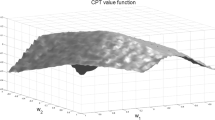Abstract
The aim of this manuscript is to analyze the monotonicity and limit properties of the optimal investment strategy in a behavioral portfolio choice model under cumulative prospect theory over risk aversion coefficient, loss aversion coefficient, and the market opportunity. We show that the optimal investment strategy is nonincreasing of the loss aversion coefficient, and strictly increasing of the Sharpe ratio for normal distributions. The monotonicity properties over risk aversion coefficient depend on the position of the investor and the goodness of the actual and perceived market. The piecewise-linear utility is also discussed. An interesting finding is that when the excess return follows an elliptical distribution, the optimal investment strategy over small mean for piecewise-power and piecewise-linear utility exhibits different limit behavior.
Similar content being viewed by others
Notes
In Sect. 4 we will consider the piecewise-linear utility, i.e., \(\alpha =1\).
For two functions g and h, \(g(t)=O(h(t))\) represents that \(\limsup _{t\rightarrow \infty }\frac{g(t)}{h(t)}\le M\) for some constant \(M>0\), while \(g(t)=o(h(t))\) represents that \(\lim _{t\rightarrow \infty }\frac{g(t)}{h(t)}=0\).
Corollary 2 in [5] shows that the CPT preference value function \(V(\cdot )\) is nonconcave on either \({\mathbb {R}}^+\) or \({\mathbb {R}}^-\). The nonconcavity of CPT preference value function brings greater difficulty in solving the optimization problem (4) analytically (see the statements in Section 5 in [5]).
Specifically, it shows that if the excess return R has a positive mean and is bounded from above, i.e., \(\mathrm {E}[R]>0\) and \(R\le M\) with probability one for some \(M>0\), then \(|\gamma _-|M>1\).
References
Arrow, K.J.: Aspects of the Theory of Risk-Bearing. Yrjö Jahnssonin Säätiö, Helsinki (1965)
Bernard, C., Ghossoub, M.: Static portfolio choice under cumulative prospect theory. Math. Financ. Econ. 2(4), 277–306 (2010)
Carassus, L., Rasonyi, M.: On optimal investment for a behavioral investor in multiperiod incomplete market models. Math. Finance 25(1), 115–153 (2015)
Deng, L., Pirvu, T.A.: Multi-period investment strategies under cumulative prospect theory. J. Risk Financ. Manag. 12(2), 83 (2019)
He, X.D., Zhou, X.Y.: Portfolio choice under cumulative prospect theory: an analytical treatment. Manag. Sci. 57(2), 315–331 (2011)
Jin, H., Zhou, X.Y.: Behavioral portfolio selection in continuous time. Math. Finance 18(3), 385–426 (2008)
Kahneman, D., Tversky, A.: Prospect theory: an analysis of decision under risk. Econometrica 47(2), 263–291 (1979)
Lou, Y.: On the investment direction of a behavioral portfolio choice model. Oper. Res. Lett. 47(4), 270–273 (2019)
Lou, Y., Strub, M., Li, D., Wang, S.: Reference point formation in social networks, wealth growth, and inequality. Working paper. SSRN (2017). http://ssrn.com/abstract=3013124
Minsuk, K., Pirvu, T.A.: Cumulative prospect theory with skewed return distribution. SIAM J. Financ. Math. 9(1), 54–89 (2018)
Pirvu, T.A., Schulze, K.: Multi-stock portfolio optimization under prospect theory. Math. Financ. Econ. 6(4), 337–362 (2012)
Pratt, J.W.: Risk aversion in the small and in the large. Econometrica 32(1–2), 122–136 (1964)
Sharpe, W.F.: The sharpe ratio. J. Portf. Manag. 21(1), 49–58 (1994)
Shi, Y., Cui, X., Li, D.: Discrete-time behavioral portfolio selection under cumulative prospect theory. J. Econ. Dyn. Control 61(7), 283–302 (2015)
Shi, Y., Cui, X., Yao, J., Li, D.: Dynamic trading with reference point adaptation and loss aversion. Oper. Res. 63(4), 789–806 (2015)
Strub, M., Li, D.: Failing to foresee the updating of the reference point leads to time-inconsistent investment. Oper. Res. SSRN (2019). http://ssrn.com/abstract=3028089
Tversky, A., Kahneman, D.: Advances in prospect theory: cumulative representation of uncertainty. J. Risk Uncertain. 5(4), 297–323 (1992)
Acknowledgements
The author would like to thank the anonymous referees for improving the quality of the paper. This research was supported by the National Natural Science Foundation of China under Grant 71971208.
Author information
Authors and Affiliations
Corresponding author
Additional information
Publisher's Note
Springer Nature remains neutral with regard to jurisdictional claims in published maps and institutional affiliations.
Rights and permissions
About this article
Cite this article
Lou, Y. Some properties of the optimal investment strategy in a behavioral portfolio choice model. Optim Lett 14, 1731–1746 (2020). https://doi.org/10.1007/s11590-019-01467-0
Received:
Accepted:
Published:
Issue Date:
DOI: https://doi.org/10.1007/s11590-019-01467-0




